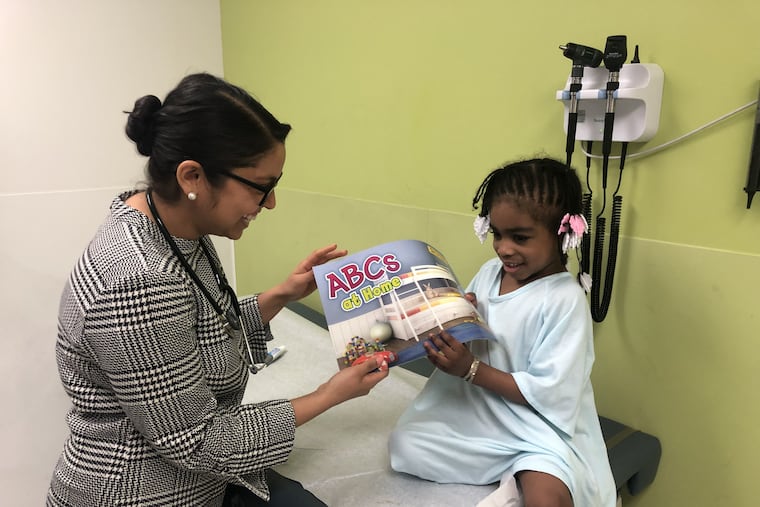This Philly pediatrician always prescribes reading to patients and parents. Here’s why.
Can books help a child live longer? The evidence says yes.

On an early Tuesday morning, my first patient of the day is a month-old boy. He is healthy. But he is from Fairhill, an especially impoverished corner of the poorest big city in America. So, statistically, his life will be an average of two decades shorter than that of a child who lives a few miles south, in Philadelphia’s Society Hill neighborhood.
Before entering the room with the customary tablet computer, stethoscope and a friendly expression on my face, I grab one more essential: a brightly colored board book, titled Baby ABCs.
Mom and I talk about her baby’s weight, sleeping, feeding — and also early brain development. I explain the profound impact of early words and attachment through daily reading (and it’s never too soon to start), singing, talking, that comes from these simple, loving, scientifically proven interventions
For 17 years, physicians, nurse practitioners and pediatric residents at our hospital, and presently, at more than 80 locations throughout the region, have been participating in Reach Out and Read of Greater Philadelphia (www.reachoutandreadphilly.org), a simple yet profound way to harness the power of a book to potentially alter a child’s health trajectory.
So, what can a book — or even a library of books — do to level the longevity field for children like my patient?
In 1900, the average life expectancy for a man born in the U.S. was 48 years; women did slightly better at 51 years. Extraordinary public advances since then — vaccines; clean water and sanitation; antibiotics; birth control, and safer childbirth — as well as medical innovations such as cancer treatments and organ transplantation, have improved average overall life expectancy to nearly 79 years.
Yet progress has stagnated and even declined due to the opioid epidemic and other “diseases of despair,” such as alcohol and substance abuse, and suicide. Less discussed, but no less important, is a lack of investments in alleviating child poverty and stress that have a profound impact on the developing brains and bodies of children, especially in the first five years of life.
Since 1989, the Reach Out and Read (www.reachoutandread.org) national program has helped caregivers create language-rich environments for young children, to promote early brain development. Research on Reach Out and Read shows that when pediatricians promote literacy readiness, there is a substantial effect on parental behavior and attitudes toward reading aloud, as well as improvements in the language scores of young children who participate.
Participants in the program were 2.5 times more likely to read to their children and even more likely to come in for their well-visit checkups.
One of the greatest predictors of high school graduation is third-grade reading levels — which, in turn, can largely be predicted by the vocabulary of a child at age 3. And that depends on a literacy rich, stimulating environment that includes daily reading from birth.
A fascinating article in the American Journal of Public Health, “Giving Everyone the Health of the Educated: An Examination of Whether Social Change Would Save More Lives than Medical Advances,” demonstrated that supporting children through high school and at least some college could decrease education-associated excess mortality exponentially. There are many factors involved in educational equity but as the authors state, “these challenges should not dissuade policymakers from tackling the conditions that cause education-associated excess mortality any more than the obstacles to curing cancer have impeded long-standing investments in that endeavor.”
Reach Out and Read is among many interventions that work on decreasing education inequality, but it’s one of the few that starts soon after birth.
Every so often, a flatbed full of boxes is wheeled to the back of our practice, which takes care of more than 20,000 children. Half the cart holds lifesaving vaccines against flu, measles, mumps and rubella, which our nurses inventory and refrigerate right away.
On the other side of the cart are cartons of books such as Goodnight Moon and If You Give a Mouse a Cookie. I inventory and store the books on shelves so my colleagues are sure to find just the right one for the families we serve. In their own way, these books are vaccines against educational disparities. As our nurse records the last vaccine, and I shelve the last book, we smile at each other and the empty boxes at our feet, collaborators in the long-term health of our patients.
Daniel R. Taylor, D.O., is an associate professor at Drexel University College of Medicine and director of community pediatrics and child advocacy at St. Christopher’s Hospital for Children.
Editor’s note: This article previously stated that Reach Out and Read was founded in 1991, not 1989.